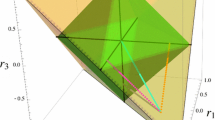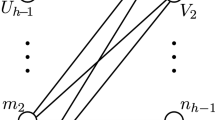Abstract
We describe a method to analyze and decompose the dynamics of a bilinear control system subject to symmetries. The method is based on the concept of generalized Young symmetrizers of representation theory. It naturally applies to the situation where the system evolves on a tensor product space and there exists a finite group of symmetries for the dynamics which interchanges the various factors. This is the case for quantum mechanical multipartite systems, such as spin networks, where each factor of the tensor product represents the state of one of the component systems. We present several examples of application.

Similar content being viewed by others
Notes
Here and in the following, the computation of the product of permutations is performed from right to left. This guarantees that they have the correct left action on the underlying space. For example, consider S3 acting naturally on \(\mathbb {C}^{3}\) by permuting the components of a vector. Then, the action on (a,b,c)T of (13)(12) is as follows. The permutation (12) switches positions 1 and 2. After that, the permutation (13) switches positions 1 and 3. The final result is (c,a,b)T. The product (13)(12) is calculated (right to left) \(1 \rightarrow 2 \rightarrow 2\), then \(2 \rightarrow 1 \rightarrow 3\), \(3 \rightarrow 3 \rightarrow 1\), so as to obtain (123). Here, the first “→” refers to the permutation (12), and the second “→” refers to the permutation (13). Consistently, the action of (123) on (a,b,c)T also gives (c,a,b)T.
Since any element of the representation acts as a multiple of the identity, irreducibility can only occur in dimension 1.
Here, the sets are meant to be ordered sets.
For a representation ρ, we can write ρ(Z) in Jordan canonical form, in appropriate coordinates. From ρ(Z)n = ρ(1)n = 1, it follows that each Jordan block must be a multiple of the identity, λ1 with λ an n th root of the identity.
We use the standard convention in group theory denoting by 〈F1,F2,...,Fs〉 the group generated by the set {F1,F2,...,Fs}.
References
Abramowitz M, Stegun IA. Handbook of Mathematical Functions. New York: Dover Publications; 1965.
Alcock-Zeilinger J, Weigert H. Compact Hermitian projection operators. J. Math. Phys. 2017;58(5):051702.
Albertini F, D’Alessandro D. Controllability of symmetric spin networks. J Math Phys 2018;59:052102.
Altafini C. Controllability of quantum mechanical systems by root space decomposition of su(n). J Math Phys 2002;43(5):2051–2062.
Arenz C, Gualdi G, Burgarth D. Control of open quantum systems: case study of the central spin model. New J Phys 2014;16:065023.
Butkovskiy AG, Samoilenko YI. 1990. Control of Quantum-Mechanical Processes and Systems, Mathematics and its Applications 56, Kluwer Academic Publisher.
Chen J, Zhou H, Duan C, Peng X. 2017. Preparing GHZ and W states on a long-range Ising spin model by global control. Physical Review A.
D’Alessandro D. Introduction to Quantum Control and Dynamics. Boca Raton: CRC Press; 2007.
D’Alessandro D. 2010. Constructive decomposition of the controllability Lie algebra for Quantum systems. IEEE Trans Autom Control, pp 1416–1421.
de Graaf WA, Algebras Lie. 2000. Theory and Algorithms. Amsterdam the netherlands: North holland.
Dixon JD. 1967. Problems in Group Theory, Dover Publications 2007, Mineola N. Y., reprinted from Blaidshell Publishing Company, Waltham, MA.
Dür W, Vidal G, Cirac JI. Three qubits can be entangled in two inequivalent ways. Phys Rev. A 2000;62:062314.
Greenberger DM, Horne MA, Zeilinger A. Going beyond Bell’s theorem. Bell’s Theorem, Quantum Theory and the Conceptions of the Universe. Dordrecht: Kluwer Academics; 1989. p. 73–76.
Fulton W, Harris J, Vol. 129. Representation Theory; a First Course Graduate Texts in Mathematics. New York: Springer; 2004.
Gauthier JP, Kupka I, Sallet G. Controllability of right invariant systems on real simple Lie groups. Syst Control Lett 1984;5(3):187–190.
Goodman R, Wallach NR. 2009. Symmetry, Representations and Invariants, Springer Graduate Texts in Mathematics.
Isaacs IM. Character Theory of Finite Groups. New York: Dover; 1976.
Keppeler S, Sjödal M. Hermitian Young Operators. J Math Phys 2014;55: 021702.
Jurdjevic V. 1996. Geometric control theory, Cambridge Studies in Advanced Mathematics, Cambridge University Press.
Jurdjević V, Sussmann H. Control systems on Lie groups. J Differ Equations 1972;12:313–329.
Lloyd S. Almost any quantum logic gate is universal. Phys Rev Lett 1995;75:346.
Long CT. Elementary Introduction to Number Theory, 2nd ed. Lexington: D. C. Heath and Company; 1972.
Polack T, Suchowski H, Tannor D. Uncontrollable quantum systems: A classification scheme based on Lie subalgebras. Phys Rev A 2009;79:053403.
Rotman J. 1995. An introduction to the theory of groups. Springer-Verlag.
Sengupta AN. 2012. Representing finite groups; A semisimple introduction. Springer.
Serre J-P. 1977. Linear Representation of Finite Groups, Graduate texts in Mathematics, No. 42.
Tung WK. Group Theory in Physics. Singapore: World Scientific; 1985.
Wang X, Burgarth D, Schirmer SG. Subspace controllability of spin \(\frac {1}{2}\) chains with symmetries. Phys Rev A 2016;94:052319.
Wang X, Pemberton-Ross P, Schirmer SG. Symmetry and controllability for spin networks with a single node control. IEEE Trans Autom Control 2012;57(8): 1945–1956.
Woit P. 2017. Quantum theory, Groups and Representations. Springer.
Zeier R, Schulte-Herbruggen T. Symmetry principles in quantum systems theory. J Math Phys 2011;52:113510.
Zimborás Z, Zeier R, Schulte-Herbrüggen T, Burgarth D. Symmetry criteria for quantum simulability of effective interactions. Phys Rev A 2015;92:042309.
Acknowledgments
The authors would like to thank Dr. F. Albertini for helpful discussions on the topic of this paper. The authors would also like to thank an anonymous referee for a very careful reading, constructive criticism and several suggestions concerning a first version of this paper.
Funding
Domenico D’Alessandro is supported by the NSF under Grant ECCS 1710558. Jonas Hartwig is supported by the Simons Foundation under Grant 637600. The authors would like to thank Dr. F. Albertini for helpful discussions on the topic of this paper.
Author information
Authors and Affiliations
Corresponding author
Additional information
Publisher’s Note
Springer Nature remains neutral with regard to jurisdictional claims in published maps and institutional affiliations.
Appendix:: Proofs of Formula (38) and of Formula (51)
Appendix:: Proofs of Formula (38) and of Formula (51)
Consider a Lie algebra \({\mathcal R}\) which has a basis \({\mathcal B}:=\{E_{j}\}\) which is invariant, as a set, under the action of the group G, i.e., if \(E \in {\mathcal B}\), \(gEg^{-1} \in {\mathcal B}\), ∀g ∈ G. Then, we can derive a basis for \({\mathcal R}^{G}\): Let \({\mathcal O}\) the set of orbits of G in \({\mathcal B}\) under the above action:
Proposition 5.2
The set of elements:
is a basis of \({\mathcal R}^{G}\). In particular, the dimension of \({\mathcal R}^{G}\) is equal to the number of orbits in \({\mathcal B}\) under the above described action of G on \({\mathcal B}\).
Proof
Since the \(E_{j} \in {\mathcal B}\) form a basis and the orbits are disjoint, then elements \({\sum }_{E_{j} \in O} E_{j}\) in (58) for different orbits O are linearly independent. Moreover, write \(F\in {\mathcal R}^{G}\) as \(F= {\sum }_{O \in {\mathcal O}} F_{O}\) where \({\mathcal O}\) is the set of orbits and FO is a linear combination of elements in \({\mathcal B}\) in the orbit O. Since gFg− 1 = F for each g ∈ G, and each orbit is invariant, we have:
which implies that, for every orbit O, and every g ∈ G, gFOg− 1 = FO. Write \(F_{O}={\sum }_{j} \alpha _{j} E_{j}\) where Ej are the elements in the basis \({\mathcal B}\) which also belong to the orbit O, and for some coefficients αj. Fix j and k and a g ∈ G so that g maps Ej to Ek. Such a g always exists because, by definition, the action of G is transitive on its orbits. By imposing gFOg− 1 = FO, using the fact that the map associated with g is a bijection from the orbit to itself, we find that αj = αk. Since, this is valid for arbitrary j and k, we find that FO must be proportional to the elements \( {\sum }_{E_{j} \in O} E_{j}\) in the set (58). □
According to the proposition, the dimension of \({\mathcal R}^{G}\) can be calculated using the Burnside’s orbit counting theorem (see, e.g., [24]):
where Fixg denotes the set of elements fixed by g, in \({\mathcal B}\).
1.1 Proof of Formula (38)
Proof
By Proposition 5.2, we have:
where # orbits is the number of orbits with respect to the action of Cn on the set of all words of length n in the four symbols 1,σx,σy,σz.
Recall Burnside counting theorem (59) which applied to our case gives:
The cyclic groupFootnote 6Cn = 〈Z〉 has a unique subgroup Hm of order m for every positive divisor m of n, namely Hm = 〈Zn/m〉. Since every element g of Cn generates some subgroup, we can partition Cn into subsets corresponding to which subgroup they generate. Then, we get:
where \({\sum }_{m|n}\) means we sum over all positive integers m which divide n. Next we use the fact that a word is fixed by g if and only if it is fixed by the cyclic subgroup 〈g〉. Thus we get from (62)
Now recall that any cyclic group has many possible generators. In particular, if g generates a group G of order m, ga generates G if and only if \(\gcd (a,m)=1\). Applying this to G = Hm, which is cyclic of order m, \((Z^{\frac {n}{m}})^{a}\) generates Hm if and only if \(\gcd (a,m)=1\). Euler’s totient function ϕ(m) counts the number of positive integers a less than or equal to m having greatest common divisor 1 with m. Therefore, Hm has ϕ(m) generators. This means that we can rewrite Eq. 63 as follows:
If m is a positive integer that divides n, then the number of words of length n in 4 letters that are fixed by Hm (equivalently, by Zn/m) is 4n/m because such words are uniquely determined by the first n/m positions, which can be arbitrarily chosen. This gives us the formula we wanted to show:
□
1.2 Proof of Formula (51)
With the same steps as in the previous proof applied to Xk rather than the whole set of words, we arrive at (cf., formula (64)):
where now the set fixed by Hm, \(\text {Fix}^{H_{m}}\) is considered in Xk rather than in the space of all 2n binary words. Recall that Hm is the subgroup generated by Zn/m. A word \(\underline {a}\) in Xk is fixed by Hm if and only if \(Z^{n/m}(\underline {a})=\underline {a}\). This in turn holds if and only n/m is a multiple of the period T of \(\underline {a}\). Therefore, the words in \(\text {Fix}^{H_{m}}\) have period T such that n/T divides k and m divides n/T. Their number by definition is w(n,m,k). Moreover, in the sum (65), m has to divide n/T and therefore n, and n/T has to divide k, so that m also has to divide k. Therefore, the nonzero terms are obtained for m at most equal to the greatest common divisor of n and k, i.e., \(\gcd (n,k)\) which gives formula (51).
Rights and permissions
About this article
Cite this article
D’Alessandro, D., Hartwig, J.T. Dynamical Decomposition of Bilinear Control Systems Subject to Symmetries. J Dyn Control Syst 27, 1–30 (2021). https://doi.org/10.1007/s10883-020-09488-0
Received:
Revised:
Published:
Issue Date:
DOI: https://doi.org/10.1007/s10883-020-09488-0
Keywords
- Decomposition of dynamics
- Symmetries
- Applications of representation theory to control
- Bilinear systems on Lie groups
- Control of quantum mechanical systems




